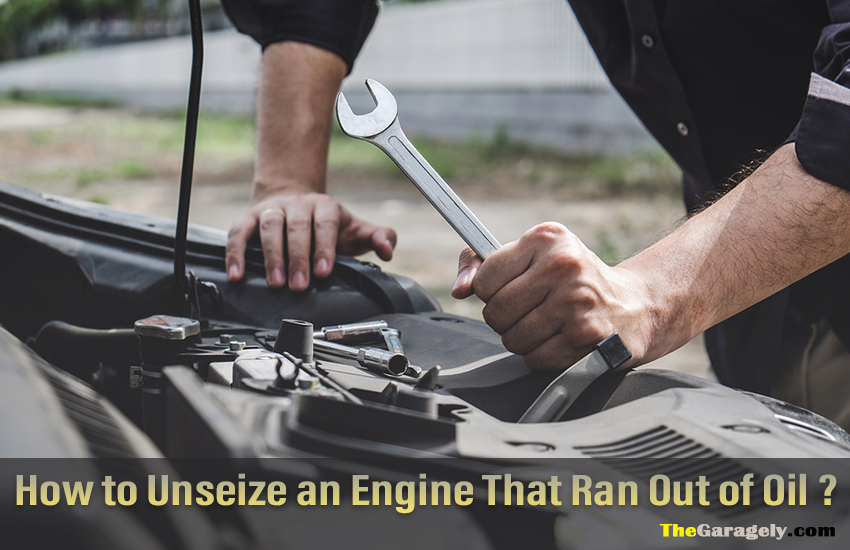
There are many causes of engine seizures, but the most common is because your car or truck oil supply runs out. Fortunately you can fix this problem without too much work!
This article will walk you through how to unseize an engine that ran out of oil due its lack of lubricant and save yourself money on expensive repairs/replacements costs.
Related Post: Best Engine Flush
Quick Navigation
What is A Seized Engine?
A seized engine is a car or other vehicle engine that cannot be started, because the pistons and other components have become stuck due to lack of lubrication. A seized engine is a car or other vehicle engine that has been unable to start due to lack of lubrication. It will not be able to start as the pistons and other components will have become stuck.
Related Post: Best Penetrating Oil for Seized Engine
What Are The Signs of A Seized Engine?
A seized engine is a term used to describe an engine that cannot turn or rotate. The engine’s pistons are frozen in their cylinders because of a lack of lubrication. The oil may have been low when the engine was running, or there may not have been any oil in the engine at all. The signs of a seized engine include the car’s engine making a knocking sound, the car’s engine overheating, and a lack of acceleration when the driver pushes the accelerator pedal.
Since a seized engine is quite serious, the driver should pull over to the side of the road and call a tow truck or a mechanic. A car owner can check a car’s engine for signs of seizure by turning the ignition key and listening for a knock sound. In some cases, a seized engine may be caused by a breakdown in the engine’s oil system. If this is the case, the engine may be able to be freed up with a change of the car’s oil.
If the driver notices that his or her car runs better when the engine is warm, he or she should get the car checked at an auto shop because the seized engine may indicate that there is something wrong with the engine’s valves. While a seized engine cannot be fixed on the spot, it can be remedied with the help of a qualified mechanic. However, if the car’s engine is seized, the mechanic will need to replace it with a new one.
How to Unseize An Engine That Ran out of Oil – 3 Important Steps to Follow!

If you’re sure of the health that your vehicle is in, then you are at the right spot. The following steps will help you ignite the engine again. Without further delay, you can go through it.
1. Pull Apart the Engine Parts
Remove the crankshaft and cylinder head with a stripped lug nut remover in the event that the oil penetration fails. This is easier with smaller engines. If there are multiple cylinders, examine each tube for faults. If you can’t discover anything, take off the cap to look for the root of the issue. Remove the cap from the incorrect cylinder, and then turn the crankshaft. Then try to shake the piston.
It is possible to use wood so that the cylinder remains in its original form. Make sure that the disk is able to slide down the cylinder’s bottom without causing damage to the crankshaft. Be cautious when you are doing this, as the maintenance techniques will not be capable of tackling any error. If you are thinking about “How to Unseize An Engine That Ran out of Oil” the first thing that comes to your mind is the stuck piston. If the piston is stuck after completing this method, it’s the right time to call experts.
2. Inspect the Damage
Whatever the cause of your engine’s seizing the cylinder, both the cylinder as well as piston will be damaged. The issue with the ring could be the cause for the broken rings. Verify the ring on the piston. If everything is fine Try rotating it inside the groove of the piston. The wedged rings are cured by oil lubrication. Replace the rings when needed. The engine that has seized because of absence of oil could cause distortion of the pistons. Clean it well in ideal light. If the skin is damaged or broken, it’s recommended to consult a professional.
3. Look into the Bottom and Reassemble
Make sure to inspect the rods that connect the wearer’s wrist pin bearing. The sound of knocking is an indication that the pins are worn. Set the connecting rods down on a surface or table and check if they’re wrapped. If you’re installing new rings, make sure that you’re aware of how the bevels are oriented. Correctly place the gaps. When the pistons are placed, coat both the piston and cylinder with the clean engine oil. It is possible to use a compressor to compress rings in the groove. Reassemble the pieces and attempt for the engine to turn. The engine will be moving freely now.
Related Post: Best Oil Extractor
How Much Does It Cost To Fix A Seized Engine?
A swift hand is needed for this difficult task. It can be very expensive. The labor for this type of repair is very labor intensive. You will need to remove the head and then drill out the pistons. The cost of the parts will depend on the type of vehicle you are repairing.
However, this repair may be easier than expected. The head can be resurfaced rather than replaced. You will need to remove the intake and exhaust manifolds in order to gain access to the pistons. A cracked block needs to be taken apart in order to replace the broken piston. If you are not able to do the work yourself, the cost of the repair will increase due to the cost of labor. You can buy a used cylinder block from a junk yard. This will help reduce the cost of the repairs.
Moreover, if you need the engine back in the vehicle right away, this option may not be a good choice. It can take several weeks to order a replacement part and then have it shipped to your location.
Final Words
Most people think that if an engine shut down because of a lack of oil, there’s nothing else to do. However, this is not the case. It is very much possible to treat the stuck engine using the proper method.
Therefore, in today’s blog, we have come up with a step-by-step guideline on how to unseize an engine that ran out of oil. We have a solution that will give you the quick answer for unlocking the engine that has been locked. That’s all. Take care!
Leave a Reply